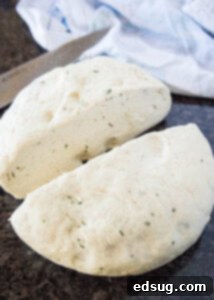Ultimate Rosemary Focaccia Recipe: Fluffy, Flavorful, and Easy to Make at Home
There’s nothing quite like the aroma of freshly baked bread filling your kitchen, and this homemade **Rosemary Focaccia** is no exception. With its signature light, airy texture, robust olive oil flavor, and a sprinkle of fresh rosemary and coarse sea salt, it’s an irresistible treat that elevates any meal. Whether you’re a seasoned baker or just starting your journey into the world of yeast breads, this forgiving focaccia recipe promises a heavenly result that’s both satisfying and surprisingly simple.
Focaccia bread has a rich history, believed to originate from ancient Roman times, serving as a foundational flatbread. Today, it stands as a testament to simple ingredients coming together to create something extraordinary. Its versatility is unmatched: enjoy it on its own, dipped in a quality olive oil, or served as a delightful accompaniment to a hearty bowl of soup, a vibrant salad, or fresh-cooked pasta. You can even transform it into the most incredible sandwich bread, offering a gourmet twist to your lunch routine. This recipe is designed to be accessible and enjoyable, making the baking process a true pleasure from start to finish. The triple rise method is key to achieving that signature fluffy interior and delicate crust, making every bite a delightful experience.

Why This Focaccia Recipe Will Become Your Favorite
Baking homemade bread might seem intimidating, but our Rosemary Focaccia recipe is designed for success, even for beginners. Here’s why it stands out:
- Minimal Ingredients, Maximum Flavor: This recipe calls for only 8 core ingredients, most of which you likely already have in your pantry. Simple, quality components come together to create a bread bursting with authentic flavor without needing a trip to a specialty store.
- Beginner-Friendly Dough: Forget complex shaping techniques! Focaccia is a flatbread, meaning there’s no need to master intricate braiding or elaborate loaf shaping. The dough is incredibly forgiving and easy to handle, making it a perfect starting point for anyone new to bread baking.
- A Fun Family Activity: Get the whole family involved, especially the kids! Pressing the iconic dimples into the dough is a satisfying and fun step that even little hands can help with (after a good hand wash, of course!). It’s a great way to introduce them to the joy of cooking and baking.
- Beyond a Side Dish: While this focaccia shines as a side, it’s incredibly versatile. Slice a thick piece horizontally to create a substantial, flavorful base for sandwiches. Its robust crust and soft interior provide the perfect contrast for your favorite fillings, transforming a simple sandwich into a gourmet meal.
- Superior Texture and Taste: The generous amount of olive oil used throughout the process, from mixing to baking, imparts an incredible richness and a golden, slightly crispy crust. The three distinct rising periods ensure a light, airy, and fluffy crumb that is truly superior to store-bought alternatives.
- Customizable for Any Palate: While rosemary and sea salt are a classic pairing, this recipe is a fantastic canvas for various toppings and herbs, allowing you to tailor it to your personal taste or whatever ingredients you have on hand. (We’ll delve into customization ideas later!)
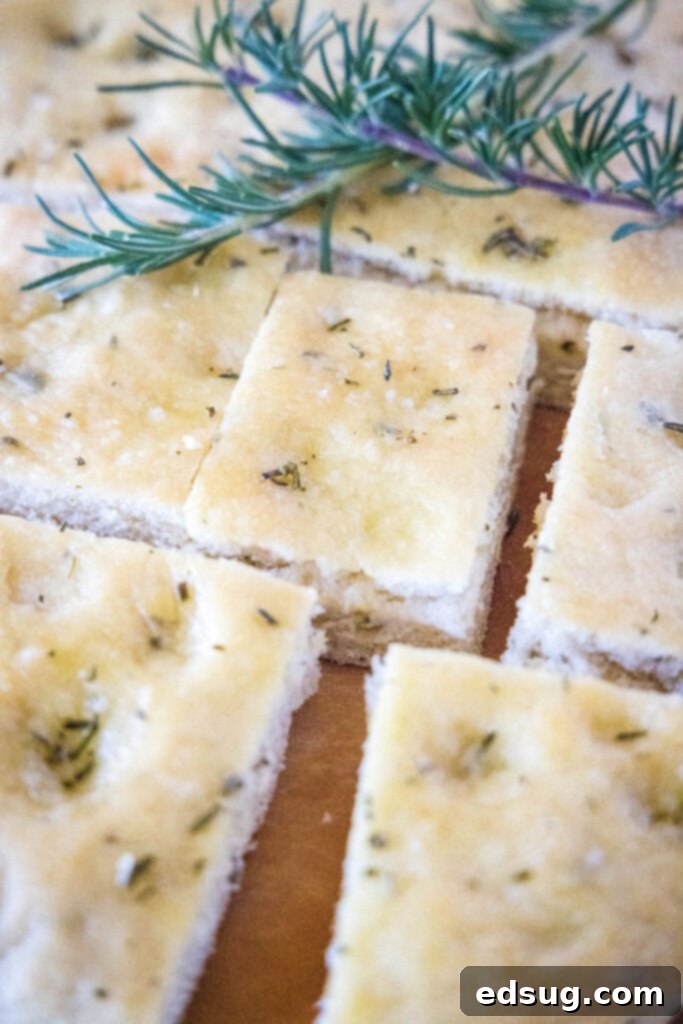
Essential Ingredients for Perfect Focaccia
Making delicious focaccia starts with understanding the role of each ingredient. Here’s a closer look at what you’ll need:
- Active Dry Yeast: This is the leavening agent that breathes life into our bread, creating that wonderfully fluffy and airy texture. Ensure your yeast is fresh and active by checking its expiration date and storing it correctly. We’ll “bloom” it first to confirm its vitality.
- Fresh Chopped Rosemary: The star herb! Fresh rosemary provides a vibrant, aromatic, and savory flavor that perfectly complements the rich olive oil. While dried can be used in a pinch, fresh offers an unparalleled depth of flavor and fragrant experience.
- High-Quality Olive Oil: Not just any oil will do! A fragrant, good-quality extra virgin olive oil is crucial here. It contributes significantly to the focaccia’s flavor profile, richness, and the development of its golden, crispy crust. The fresher and higher quality your olive oil, the more exceptional your bread will taste. Don’t be shy with it – focaccia thrives on a generous amount.
- Coarse Sea Salt: This isn’t just for seasoning the dough; it’s a vital topping. Sprinkling coarse sea salt over the top before baking adds a beautiful crunchy texture and bursts of salty flavor that cut through the richness of the bread. It provides a delightful contrast to the soft crumb.
- Warm Water (for yeast activation): This initial portion of water needs to be precisely warm (around 100-110°F or 38-43°C) to gently awaken and activate the yeast. Too hot, and it kills the yeast; too cold, and it won’t activate properly. This step ensures a good rise.
- Room Temperature Water (for dough hydration): The larger portion of water in the recipe, it provides essential hydration for the bread dough, helping it come together and develop its structure during kneading and rising. Using room temperature water helps maintain a consistent dough temperature.
- Bread Flour: This flour is specially designed for bread making. It has a higher protein content than all-purpose flour, which leads to greater gluten development. This gluten network gives the focaccia its characteristic chewiness, strength, and ability to hold those wonderful air pockets.
- All-Purpose Flour: By combining all-purpose flour with bread flour, we achieve a perfect balance. All-purpose flour contributes to a lighter, more tender crumb, preventing the focaccia from becoming too dense or overly chewy. This blend ensures the ideal focaccia texture – light yet substantial.
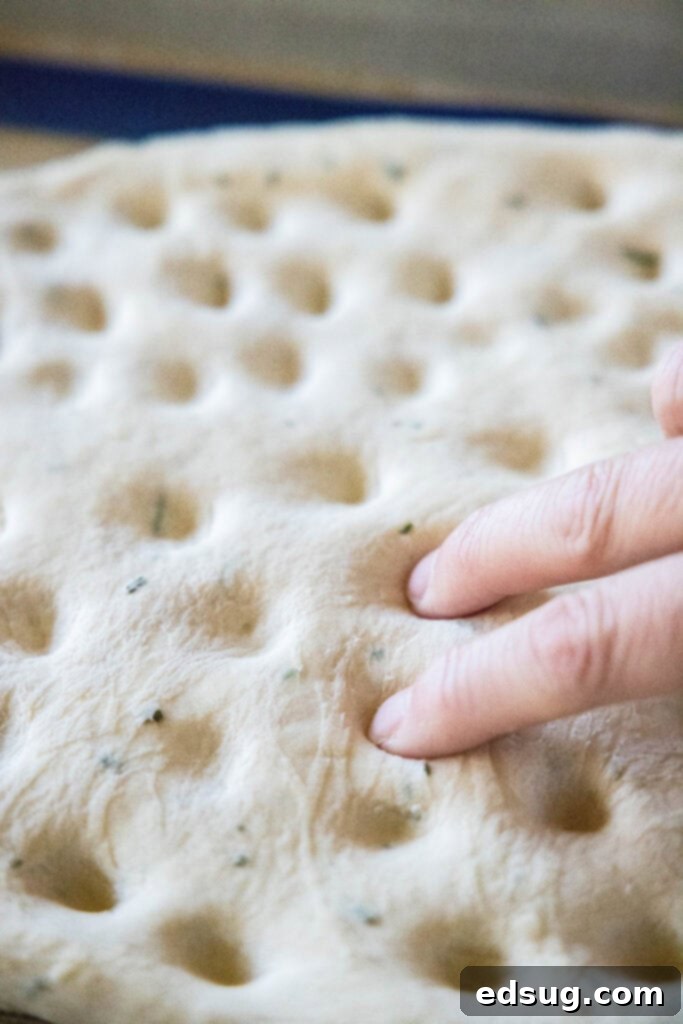
Crafting Your Homemade Rosemary Focaccia: A Step-by-Step Guide
Follow these detailed steps to bake your own perfect, fluffy rosemary focaccia:
- Activate the Yeast (Bloom): In a small bowl or liquid measuring cup, gently stir the 2 1/4 teaspoons of active dry yeast into 1/3 cup of warm water (ideally between 100-110°F or 38-43°C). Let this mixture sit undisturbed for about 10 minutes. You’ll know your yeast is active and healthy when it becomes foamy and bubbly on the surface, indicating it’s ready to work its magic.
- Combine Liquids with Yeast: In a large mixing bowl, combine 2 1/4 cups of room temperature water with 2 tablespoons of olive oil and your now foamy yeast mixture. Stir well to ensure everything is thoroughly integrated.
- Incorporate Flours, Salt, and Rosemary: Add 2 cups of bread flour and 1 tablespoon of salt to the liquid mixture. Mix them together until just combined. Then, stir in 2 tablespoons of the fresh chopped rosemary. The dough will be shaggy at this stage.
- Gradually Add Remaining Flour: Begin adding the remaining 4 1/2 cups of all-purpose flour, one cup at a time. Mix thoroughly after each addition until the dough starts to come together into a coherent ball. It might still be a bit sticky, which is perfectly normal for focaccia dough.
- Knead the Dough: Turn the dough out onto a lightly floured surface. Knead the dough for a full 8 minutes. This consistent kneading is crucial for developing the gluten, which gives focaccia its desired chewy texture and structure. The dough should become noticeably smooth and elastic. If it’s too sticky to work with, sprinkle on a little extra flour, but avoid adding too much, as this can make the bread tough.
- First Rise (Bulk Fermentation): Lightly oil the inside of a large bowl (you can use cooking spray or a teaspoon of olive oil). Place the kneaded dough into the bowl, turning it once to coat all sides with oil. Cover the bowl tightly with plastic wrap or a clean kitchen towel. Let it rise in a warm, draft-free place for about 90 minutes, or until the dough has visibly doubled in size. This slow rise builds flavor and strength.
- Divide and Shape: Once risen, gently punch down the dough to release the air. Divide the dough into two equal balls. Drizzle a generous amount of olive oil onto two separate baking sheets, spreading it evenly across the bottom. Place one dough ball on each sheet. Using your fingertips, gently spread and press each dough ball out to an approximate 1-inch thickness. Don’t worry about perfect circles or rectangles; rustic shapes are charming for focaccia.
- Second Rise: Loosely cover both baking sheets with plastic wrap or a kitchen towel. Let the dough rise again for an additional 30 minutes. This shorter rise helps the dough relax and begin to develop more air pockets.
- Create Dimples and Third Rise: After the second rise, uncover the dough. Using your fingertips, firmly press half-inch deep dimples all over the surface of each dough piece. These dimples are characteristic of focaccia and help create pockets for olive oil and toppings. Cover the dough again and let it rise for a final 1-2 hours, or until it has nearly doubled in size once more. This third rise ensures maximum fluffiness and an open crumb structure.
- Prepare for Baking: While the dough completes its third rise, preheat your oven to 400°F (200°C).
- Top It Off: Once the dough is ready, generously brush the entire surface of both focaccias with additional olive oil. Sprinkle them evenly with coarse sea salt and the remaining 1 tablespoon of minced fresh rosemary. The olive oil prevents the crust from drying out and helps the toppings adhere.
- Bake to Perfection: Place the baking sheets in your preheated oven. Bake for 20-25 minutes, or until the focaccia is beautifully golden brown and cooked through. To check for doneness, you can lightly tap the bottom of the bread; it should sound hollow.
- Cool and Serve: Once baked, remove the focaccia from the oven. Allow it to cool on the baking sheets for at least 10 minutes before transferring to a wire rack or cutting board. This cooling period helps the internal structure set and prevents sogginess. Slice and serve warm, and prepare for rave reviews!
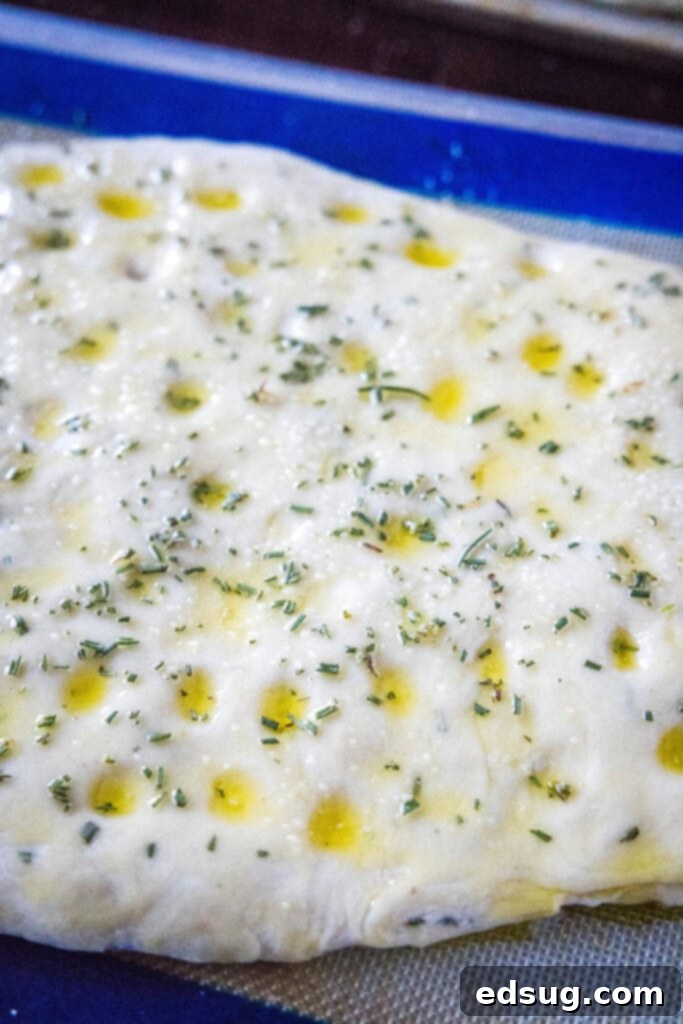
Expert Tips for Your Best Focaccia Yet
Achieving bakery-quality focaccia at home is easier than you think with these helpful tips:
- Check Yeast Freshness: Always verify the expiration date on your yeast package. For extra assurance, if your yeast doesn’t foam during the initial blooming step, it’s likely dead and should be replaced to avoid flat bread.
- Store Yeast Properly: To keep your yeast viable for longer, store opened packages in an airtight container in the refrigerator or freezer. This preserves its activity.
- Customize Your Herbs: While rosemary is classic, feel free to experiment! Other fresh herbs like finely chopped parsley, basil, oregano, or a touch of sage (use sparingly as it’s strong) make fantastic toppings. Dried herbs can also work, but use about a third of the amount of fresh herbs, as their flavor is more concentrated.
- Explore Savory Toppings: Beyond herbs, focaccia is a canvas for savory additions. Try thinly sliced red onions, cherry tomatoes (halved), black olives, roasted garlic cloves, or a sprinkle of Parmesan cheese for added depth. Caramelized onions are also a divine choice.
- Salt Alternatives: If you don’t have coarse sea salt, good quality kosher salt is an excellent substitute. Avoid fine table salt, as it can be too overpowering and dissolve quickly. Flaky sea salt, like Maldon, is also a wonderful finishing touch for both flavor and texture.
- Don’t Rush the Rise: The three rising periods are crucial for focaccia’s signature airy texture and rich flavor development. Resist the urge to shorten them, especially the final rise. Patience is key for light and fluffy bread.
- Embrace the Olive Oil: Focaccia loves olive oil! Don’t skimp on brushing the pan or the dough before baking. This contributes to the bread’s flavor, moistness, and creates that desirable crispy, golden crust. Consider infusing your olive oil with a crushed garlic clove for an extra layer of flavor.
- Use the Right Pan: A standard rimmed baking sheet works perfectly. For an even crispier bottom crust, some bakers prefer a cast-iron skillet, but it’s not strictly necessary.
This recipe yields two generous loaves of focaccia. To freeze, we recommend dividing each loaf in half or into desired serving sizes. First, wrap each portion tightly in plastic wrap to protect it from freezer burn. Then, wrap it again securely in aluminum foil. This double-layer protection helps maintain its freshness and flavor in the freezer for up to 3 months.
To reheat frozen rosemary focaccia, first remove all plastic wrap. Keep it wrapped in the aluminum foil and place it directly into a preheated 350°F (175°C) oven for about 10-15 minutes. For an extra crispy crust, remove the foil for the last 2-4 minutes of reheating. This method allows the bread to warm through gently while regaining its delightful texture.
Yes, you absolutely can! After the first rise, you can gently punch down the dough, place it in an oiled bowl, cover it tightly with plastic wrap, and refrigerate it overnight (up to 24 hours). This slow fermentation can even enhance the flavor. When you’re ready to bake, remove the dough from the refrigerator and let it come to room temperature for about 30-60 minutes before proceeding with steps 7 (divide and shape) onwards. This ensures the yeast wakes up and can perform its final rises effectively.

Delicious Ways to Serve Your Rosemary Focaccia
The beauty of rosemary focaccia lies in its incredible versatility. It can be the star of the show or a perfect supporting act for a variety of meals and occasions:
- Classic Dipping: The simplest and often most satisfying way to enjoy focaccia is to tear off a piece and dip it into a high-quality olive oil. For an elevated experience, try it with this herbed Bread Dipping Oil, bursting with garlic and spices.
- Soup & Stew Companion: Focaccia is the ideal partner for a warm bowl of soup or a hearty stew. Its porous texture is perfect for soaking up rich broths and sauces. Imagine it alongside this comforting Italian Meatball Soup for an authentic Italian feast, or with a lighter, vibrant Carrot Ginger Soup for a meat-free delight.
- Perfect with Pasta: Italian bread and Italian pasta are a match made in heaven. Serve slices alongside your favorite pasta dish, from a classic marinara to a creamy Alfredo, to complete your meal.
- Ultimate Sandwich Bread: As mentioned, focaccia makes an exceptional sandwich base. Slice it horizontally and fill it with deli meats, fresh mozzarella, roasted vegetables, pesto, or a simple smear of hummus for an extraordinary lunch. It’s especially delicious toasted.
- Appetizer Platter: Cut into small squares or strips and arrange it on a charcuterie board with cured meats, cheeses, olives, and marinated vegetables for an elegant appetizer spread.
- Alongside Salads: Serve a warm slice next to a fresh, crisp salad. The savory bread provides a lovely contrast to bright greens and tangy vinaigrettes.
- With Mediterranean Flavors: Pair it with other Mediterranean-inspired dishes like roasted chicken, grilled fish, or vegetable platters such as my Italian Chicken Bake and Italian Meatball Caprese Skewers for a balanced and flavorful meal without the “food coma.”
- Breakfast Treat: While unconventional, focaccia can be a delightful addition to breakfast. Lightly toast a slice and serve with scrambled eggs, or even as a base for an open-faced breakfast sandwich.
Explore More Delicious Bread Recipes
If you loved making this focaccia, you’ll surely enjoy exploring other homemade bread options. Expand your baking repertoire with these fantastic bread recipes:
- French Bread Dinner Rolls – These charming rolls boast a delightful crisp outside and a super soft, tender inside, making them perfect for any meal or occasion.
- Naan Bread – Dive into the world of Indian cuisine with this classic flatbread. It’s wonderfully soft and chewy, making it an ideal accompaniment for rich soups, flavorful curries, and lentil dishes.
- Southern Style Cornbread – A true comfort food, this sweet and satisfying cornbread is a staple. It’s moist, flavorful, and perfect with chili, stews, or a dollop of butter.
- Cheesecake Factory Brown Bread – Recreate a restaurant favorite at home with this Cheesecake Factory copycat. It’s a barely-sweet, wholesome whole-grain delight that’s incredibly addictive.
- Potato Bread with Chives – Experience the incredible tenderness of potato bread, enhanced with savory flecks of fresh chives. It’s an ideal accompaniment to any savory dish, from roasted meats to creamy dips.
- Honey Oat Bread – This simple no-knead bread is lightly sweetened with honey and boasts a delightful texture from oats. It’s perfect for everyday sandwiches, morning toast, or simply enjoyed with butter.
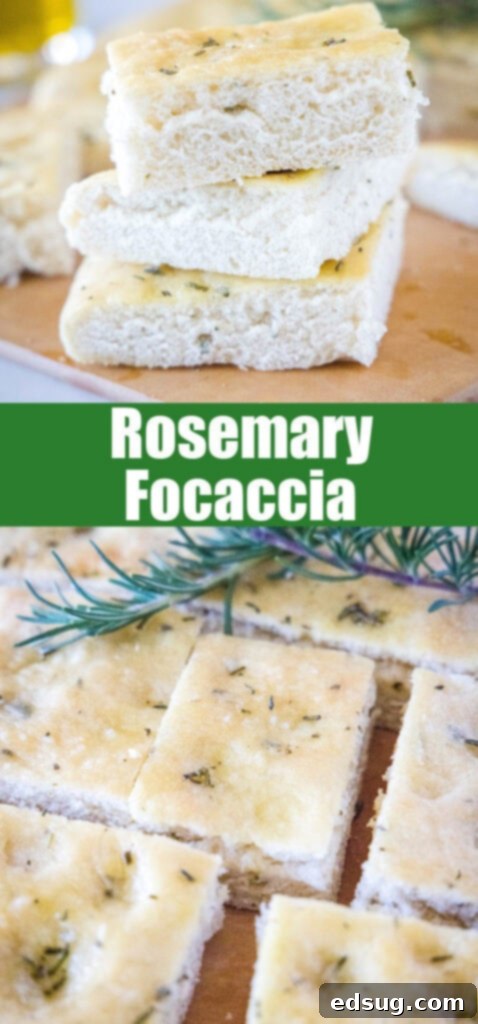
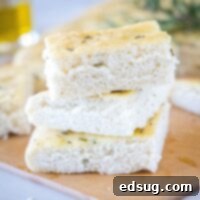
Rosemary Focaccia
Pin Recipe
Rate Recipe
Print Recipe
Ingredients
- 2 1/4 teaspoons 1 envelope active dry yeast
- 1/3 cup warm water, (105-110º F)
- 2 1/4 cups room temperature water
- 2 Tablespoons olive oil
- 3 cups bread flour
- 4 1/2 cups all-purpose flour
- 1 Tablespoon salt
- 3 Tablespoons fresh chopped rosemary, divided
- Coarse sea salt for sprinkling
- Additional olive oil for pan and brushing
Instructions
-
In a liquid measuring cup, stir together 1/3 cup of warm water (105-110º F) with the yeast. Let it rest for 10 minutes, until it is nice and foamy, indicating the yeast is active.
-
In a large bowl, mix together 2 1/4 cups of room temperature water, 2 tablespoons of olive oil, and the foamy yeast mixture until well combined.
-
Add in 2 cups of bread flour and 1 tablespoon of salt and mix thoroughly to combine.
-
Mix in 2 tablespoons of the fresh chopped rosemary. Then, gradually add the remaining 4 1/2 cups of all-purpose flour, 1 cup at a time, mixing until all the flour is incorporated and the dough comes together in a shaggy ball.
-
Turn the dough onto a lightly floured surface. Knead for 8 minutes, until the dough is smooth and elastic. If the dough is too sticky, add additional flour sparingly, one tablespoon at a time, until it is manageable.
-
Lightly spray a large bowl with non-stick spray or brush with olive oil. Place the dough into the oiled bowl, turning once to coat. Cover the bowl with plastic wrap or a clean kitchen towel and let it rise in a warm spot for 90 minutes, or until doubled in size.
-
Gently deflate the dough and divide it into 2 equal balls.

-
Spread a generous amount of olive oil onto two baking sheets. Place a ball of dough onto each baking sheet and gently spread it out with your fingertips to a thickness of about 1 inch. Cover both sheets loosely and let the dough rise for another 30 minutes.
-
Using your fingertips, gently press half-inch deep dimples all over the surface of each dough. Re-cover and let rise for approximately 1-2 hours, until the dough has nearly doubled in size once more and feels puffy.

-
Preheat your oven to 400º F (200°C).
-
Brush the surface of both focaccia loaves generously with additional olive oil. Sprinkle evenly with coarse sea salt and the remaining 1 tablespoon of chopped rosemary.

-
Bake for 20-25 minutes, or until the bread is cooked through, golden brown on top, and sounds hollow when tapped gently on the bottom.
-
Let the focaccia cool on the baking sheets for at least 10 minutes before slicing and serving. This helps the crumb set and improves texture.
Notes
Nutrition
Nutrition information is automatically calculated, so should only be used as an approximation.
Additional Info
Like this recipe? Leave a comment below!
I created a fun group on Facebook, and I would love for you to join us! It’s a place where you can share YOUR favorite recipes, ask questions, and see what’s new at Dinners, Dishes and Desserts (so that you never miss a new recipe)!
Be sure to follow me on Instagram and tag #dinnersdishes so I can see all the wonderful DINNERS, DISHES, AND DESSERTS recipes YOU make!
Be sure to follow me on my social media, so you never miss a post!
Facebook | Twitter | Pinterest | Instagram

